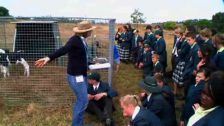Landscaping Lifestyles at WorldSkills
On the last day of competition, Simon Buchanan takes us through the Landscape Construction site, showing us what the competitors have accomplished so far and what they are trying to achieve.
About Landscape Construction At WorldSkills:
In Landscape Construction, competitors must first be able to understand and interpret a plan drawing. They have 18 hours to execute a built structure, some paving and a plant arrangement. This year there is a totally new design and for the first time the competition area is on site with the rest of the WorldSkills categories. In previous years, the category was run at a satellite location off site, which hardly attracted many spectators. At the convention centre this year they are expecting approx 70, 000 visitors so there’ll be added pressure on competitors.
The added attention will be good to prepare the landscapers for the World Olympics in Calgary 2009 when the whole globe will be watching. There are 8 competitors and they will have to make a paving section, curved stone wall at the rear and a European/Asian screen over three days. They must be quality constructions, correct dimensions, final presentation must be good, the use of ‘green space’ in which they are given the same plants and they can choose how they wish to plant them.
This is also called ‘soft-scape development’. They bring their own hand tools but not the big stuff like wheelbarrows etc. Australia has done quite well internationally and has come in fourth each year since going to Switzerland. The Swiss home team won that year and last year Japan won (also the home team) which means there is distinct home ground advantage in international landscaping competition.
About Simon:
Simon Buchanan is 23 years old and a past WorldSkills national gold medallist and international competitor at Japan, where he came fourth out of sixteen countries in the group competition. This year he is judging the nationals and becoming a mentor/ trainer to those who make the international team going to Calgary WorldSkills 2009. Simon runs his own business, Land Art Landscapes in Melbourne and he emphasises that “WorldSkills has been a huge reason for his success” in running his own business.
As a judge, Simon is aware of the added pressure of the crowds watching in Sydney and says “it’s good, readiness in preparation for international competition” and he’ll be looking for “professionalism towards their work, care with OHS, skill level and how well they construct.”
Simon loves “doing something different… don’t get sick of one task…likes variation and working outdoors…building gardens is rewarding...lots of satisfaction bringing gardens to life.”
Being a judge will be different to competing, it will be a relief but he enjoys the whole process and volunteers his time freely because he loves being involved in WorldSkills. In landscaping there is no shortage of work although attitudes and approaches to the environment have changed. In Simon’s business he has started installing water tanks and systems that use ‘grey water’ (i.e. recycled water), he also prefers to use Australian natives and drought resistant plants. Choosing grasses is important too and there has been a rise in the use of synthetic grass recently to reduce water usage.
Low maintenance gardens are key to working with the lack of water in many Australian cities, creating ‘hard areas’ with paving and decking also decreases the amount of land to be watered. Simon has embraced the environmental challenges facing landscaping and his business has been doing quite well out of installing water tanks.











